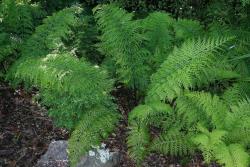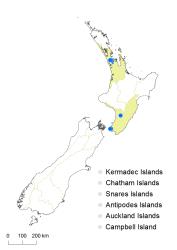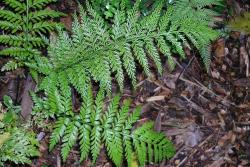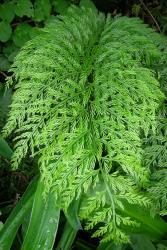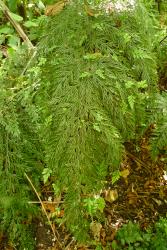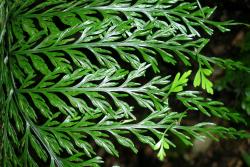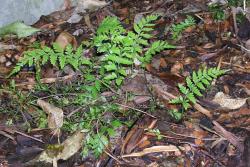Terrestrial or rupestral ferns. Rhizomes short-creeping, bearing scales. Rhizome scales narrowly ovate with filiform apices, 5–20 mm long, 0.5–1.5 mm wide, dark brown, clathrate. Fronds 680–1200 mm long. Stipes 50–400 mm long, dark brown proximally and abaxially, green distally and adaxially, bearing narrowly ovate scales. Rachises green, scaly. Laminae 2–3-pinnate-pinnatifid, ovate or elliptic, narrowed to a pinnatifid apex, 130–1000 mm long, 80–500 mm wide, yellow-green (in exposed conditions) to dark green on both surfaces, herbaceous to coriaceous, bearing scattered scales, lacking hairs, bearing bulbils near the apices of primary and secondary costae; fertile and sterile pinnae dimorphic, the fertile narrower and more divided, occurring towards the lamina apex. Primary pinnae in 14–34 pairs below pinnatifid apex, usually overlapping; proximal pinnae ovate or narrowly ovate, those at mid-lamina narrowly ovate or narrowly elliptic; the longest at or below the middle, 40–300 mm long, 20–110 mm wide, apices acuminate, bases stalked. Secondary pinnae gradually decreasing in length along each primary pinna to the distal end; the longest proximal secondary pinnae ovate or narrowly ovate, 13–62 mm long, 7–18 mm wide, bases stalked; apices of fertile secondary pinnae acute or acuminate, the sterile acute or obtuse; the distal secondary pinnae linear, straight or falcate, apices acute, bases adnate. Tertiary segments linear; the longest fertile segments 5–11 mm long, 1–1.5 mm wide, sometimes deeply divided; the sterile shorter and broader. Sori submarginal; indusia 3–7 mm long, straight; free margins of indusia entire. Spores aborted, of irregular size and shape.
Plants of Asplenium ×lucrosum are widely cultivated and occasionally naturalised in New Zealand. They are hybrid plants with aborted spores but capable of propagation by means of their abundant bulbils. They are also dimorphic, either producing separate sterile and fertile fronds, or frequently a mixture of sterile and fertile pinnae on the same frond. The fertile pinnae are more highly dissected and tend to occur towards the apex of the frond. Such dimorphism does not occur in either A. bulbiferum or A. gracillimum, with which A. ×lucrosum has been confused. The aborted spores are an additional distinguishing character.
North Island: Auckland, Southern North Island.
Altitudinal range: 20–40 m.
Asplenium ×lucrosum is a widely cultivated plant. Young plants, growing by vegetative propagation from bulbils, have been observed near botanic gardens in Wellington and Palmerston North (Perrie et al. 2005) and on Matiu / Somes Island, Wellington Harbour. There are also records from Auckland City. The plant is regarded as a casual adventive and, despite producing only sterile spores, has the potential to spread by means of its bulbils.
Occurs under native forest adjacent to planted areas in botanic gardens, or near areas of restoration planting.
Perrie et al. (2005). Voucher: WELT P020582, 2003.
Perrie et al. (2005) showed that Asplenium ×lucrosum is a hybrid between A. dimorphum from Norfolk Island and A. bulbiferum from New Zealand, which arose in cultivation. Based on chloroplast DNA data, the Norfolk Island A. dimorphum is the maternal parent, and the parent from which the hybrid inherits its frond dimorphism. The other parent is likely to be A. bulbiferum, based on its similar morphology and bulbiferous habit.



